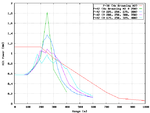KrazyKraut
Banned
- 337
- Apr 21, 2008
Where's the difference? Nose armament was seen as more effective / efficient by some air forces. Thus they made it a requirement and subsequently it was incorporated in those designs. One leads to the other.I believe the mounting of guns in the nose or the wing of a particular aircraft tended to be more of a design consideration, rather than a gun 'effectiveness' issue.
No. When not exactly at the point of convergence (harmonization), shots from a centerline gun deviate from the point of aim only on the y-axis, while those of a wing mounted gun deviate from that point on both y- and x-axis.As Henning pointed out in an earlier post, the highest chance of hitting an airborne target from an airborne gun platform, was at the ranges where wing mounted guns were harmonized. The only place I see an advantage is at extremely close range where all guns could be brought to bear on an unsuspecting target. Anecdotal evidence suggests that most WWII pilots fired at much longer ranges, often at too long a range.
Contrary to what you wrote, a centerline gun is beneficial at all ranges, before or beyond harmonization range.
Overall it didn't matter that much because fighters with wing guns usually had a lot of them (except early P-51s). I like the statement that this kind of weaponry was effective but not efficient. There's something to it. Things would've probably been a bit different if they had to fight heavy bombers, but that's another story.
In my opinion, for most combinations the difference is not bigger than the typical error a pilot would make anyway. As said by claidemore, a certain amount of spread is probably even beneficial. Up to convergence range, hit probability was apparently seen as sufficient, else you wouldn't see so many mixed gun platforms (basically all fighters except for early British and of course American single engined fighters). Even with the same type of guns there is some minor trajectory deviation between inner and outer guns.Just a thought about mixing the cannons and MG's together on an aircraft ..... didnt the projectiles have different trajectories that made it near impossible to have all of them fired at once and hit what you thought you were aiming for?
Either you fire you MG's or your cannons, but not both (unless youre so close it didnt matter).


